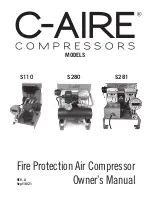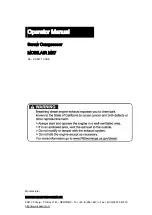
HSO 2024 to HSO 2035 Installation, Operation and Maintenance Manual
Page 4 of 94
Publication 2-119
Issue 1.2 : 03/10
Examination of Pressure Systems
Within the United Kingdom, statutory regulations require the user to
prepare a ‘written scheme of examination’ to cover all parts of the plant
subject to pressure. It is a requirement that the scheme be introduced
before the plant is put into operation for the first time. If the plant is
modified, the written scheme of examination must be reviewed and
updated to incorporate these modifications.
Noise Hazard
The majority of noise emanating from refrigeration plant is produced by
the compressor(s), pump(s) and fan(s) and the motors which drive them.
While short term exposure to the typical average noise level which might
be encountered is unlikely to be detrimental to health, ear defenders
should be worn by those personnel who have to work near major sources
of noise. The type of ear defenders worn must not compromise the
wearing of other essential safety clothing, for example, goggles or a
respirator.
Electrical
Electrical wiring must be sized and installed to such a standard as to
meet the requirements of the national or local codes pertaining to the
area in which the installation is taking place.
The electrical power used in this equipment is at a voltage high enough to
endanger life. Before undertaking maintenance or repair procedures on
electrical equipment, personnel must isolate equipment from the electrical
supply and test to verify that isolation is complete. Precautions must be
taken to prevent circuits being inadvertently energised, for example,
withdraw the mains fuses, or, if this is not practicable, disconnect the
equipment from the supply before work commences.
If the supply cannot be disconnected or must remain connected to permit
functional testing, fault diagnosis and repair should only be undertaken by
persons who are aware of the hazard and who have taken adequate
precautions to avoid direct contact with dangerous voltages.
If electrical equipment overheats or a fault occurs, it must be
disconnected from the supply and allowed to cool. Overheating may
damage the insulation system, cables, mouldings, gaskets and seals.
The materials used in these components may contain complex organic
compounds which, when degraded by heat or electrical action, produce
chemical compounds in gaseous, liquid or solid forms. Many of these
gaseous and liquid product compounds are highly flammable and toxic.
If it is necessary to extinguish a fire in electrical equipment, follow the
advice given in the Fire Precautions Act 1971, ‘Guide to Fire Precautions
in Existing Places of Work that require a Fire Certificate’ available from
HMSO. Do not approach the equipment until the fire has been
extinguished and the equipment is cool.





































